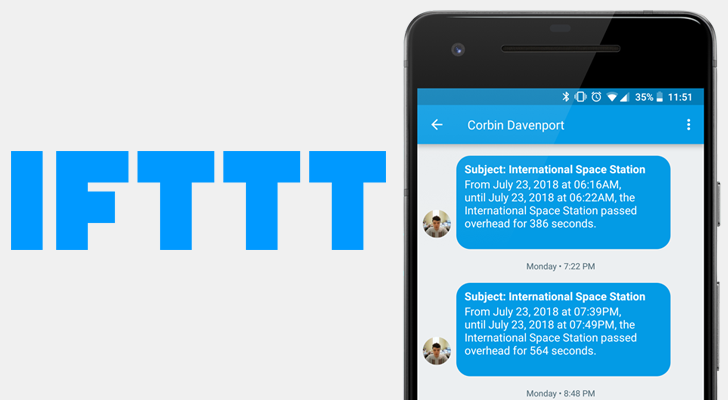If This Then That, or IFTTT for short, is a pretty great service. There are hundreds of connected services, allowing you to automate your email, smart home, social networks, and more. Many people use the service to set up push notification alerts, like one for when the International Space Station flies over your home or for when the pollen count is high in your area.
Push notifications are great, but they require you to install the IFTTT mobile app, which not everyone wants to do. IFTTT also supports sending notifications via SMS, but that is limited to just 100 messages per month. If you live outside the United States or Canada, you only get ten messages every month. That's basically useless.
Thankfully, there's a way to send an unlimited number of SMS messages using IFTTT in any country, using a feature that nearly every carrier supports - SMS gateways.
What are SMS gateways?
Almost every carrier on the planet allows text messages to be sent to mobile phones via email, using the respective carrier's 'SMS gateway.' For example, AT&T's gateway domain is "txt.att.net." So if someone's phone number is 123-456-7890, the email address would be 1234567890@txt.att.net. Anything sent to that email address will be delivered as an SMS message to the specified number.
There are multiple sites that list the SMS gateway domains for each carrier, like email2sms.info. Some carriers require you to put the country code before the phone number (the US code is 1, for example). Here are the gateways for major US carriers:
- AT&T: number@txt.att.net
- Sprint: number@messaging.sprintpcs.com
- Verizon: number@vtext.com
- T-Mobile: number@tmomail.net (must put '1' before the number)
Once you find out what your SMS gateway address is, you can use it with IFTTT. It's a good idea to send a test email first, just to make sure everything is working.
Sending IFTTT notifications with SMS gateways
You have two options when it comes to making IFTTT applets that sent something to your SMS gateway.
Method #1: The Email service
The first option is to use IFTTT's Email service. If you go to the Email service settings and click on 'Edit Connection', you can enter your SMS gateway address. This does not change the email associated with your IFTTT account.
Once you verify the address, all your applets that send you an email will actually send you a text instead. You can find a list of sample Email applets here. The downside to this method is that IFTTT adds a ton of extra information to the bottom of each message, including a long link for managing whatever applets you set up.
An SMS message sent using IFTTT's Email service
There is no way to disable this behavior. However, if you use Gmail, there is an alternative method.
Method #2: The Gmail service
The IFTTT Gmail service allows you to automatically send emails to any address from your Gmail account. When creating an applet, select Gmail as the action service, then pick the 'Send an email' action. On the final screen, just enter your SMS gateway address in the 'To address' box.
The main advantage to this method is that there is no junk at the end of every message, like there is when using the standard Email service. You can also add up to 20 email addresses, which opens up more possibilities. For example, you could have SMS messages sent to your entire family if it's going to rain later in the day (using the Weather Underground service), so everyone knows to bring a jacket to work/school.
Messages sent using the Gmail service don't have any extra information at the end.
Keep in mind that activating the Gmail service gives IFTTT access to send or receive messages from your Gmail account. Additionally, messages sent by IFTTT will appear in your Sent folder.
If you don't want to keep the IFTTT mobile app installed, sending messages to your SMS gateway is an easy way to achieve the same functionality. Let us know in the comments what fun applets you create.

